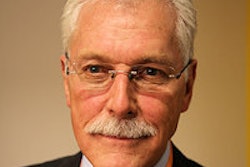
The European Society of Radiology (ESR) has issued a strongly worded statement that it will not tolerate copycats and cheats. The warning forms part of a broad-ranging document about good scientific practice and publishing that has been posted online by Insights into Imaging on 23 May.
 The European Society of Radiology has taken steps to address plagiarism and research fraud. Image courtesy of ESR.
The European Society of Radiology has taken steps to address plagiarism and research fraud. Image courtesy of ESR.
ESR is making extensive use of plagiarism-detection software to identify highly and suspiciously similar written text. In cases in which word-for-word plagiarism or redundant publication is suspected, editors will carry out further investigation with the help of editorial staff, expert reviewers, and original copyright holders, according to the statement, which was prepared by the ESR Publications Committee in 2011 and was approved by the ESR Executive Council in February 2012. If their suspicion is reliably confirmed, then action will be taken, as recommended by the Committee on Publication Ethics (COPE).
"It is hoped that this article will act as a 'wake-up call' to prospective authors and to heads of departments alike," the statement reads. "It is perhaps more difficult to spot duplication in case reports submitted to an online teaching file or abstracts to conference proceedings. However, the ESR is determined that exactly the same standards should be applied to all submissions to the society."
It is good practice for each published article to be countersigned by a "guarantor" for the entire study, who may be the senior author but could be the head of a department or research lead, the authors recommended.
They noted plagiarism can take many forms and vary in degree but is considered intellectual dishonesty. Possible scientific misconduct includes:
- Redundant publications (submitting the same article to different journals/media concurrently)
- Data fabrication/falsification (intentional alteration of research processes and results, as well as image manipulation)
- "Salami slicing" (dividing the same study/patient group into two or more articles and submitting them as different studies)
- Overlapping publications (submitting a similar manuscript to different journals with different readerships)
- Gift authorship (co-authorship awarded to a person with no or little involvement in the research process)
- Undisclosed conflicts of interest
"It is appreciated that some of these events may occur unintentionally or may sometimes arise out of naivety," the authors conceded. "Accidental or unintentional plagiarism may occur when authors are largely unaware of citation and documentation rules guiding scientific practice. Inexperience with research methods, ignorance of citation rules, and sloppiness are among the most common causes for this type of plagiarism."
Plagiarism ranges from the unreferenced use of others' published and unpublished ideas, including research grant applications, to submission under "new" authorship of a complete paper, sometimes in a different language, according to COPE. It may occur at any stage of planning, research, writing, or publication, and it applies to print and electronic versions.
The ESR's Publications Committee thinks reviewers have a key role in exposing plagiarism. Their knowledge of the area of science in question and awareness of the recent literature in their areas of expertise means that the misappropriation of source material is often brought to light by alert reviewers.
The committee advises authors to notify the editor of previous articles that exhibit a high degree of similarity to the subject matter, theory, data, or methodology used. Also, the discussion of any article should clearly point out exactly how the current article builds on previous work and explain whether it confirms/refutes previous published statements.
Depending on the severity of the scientific misconduct, the editors may decide to impose sanctions against authors who have transgressed. This can involve a letter to the head of the department or university dean, informing them about the malpractice and asking for an official explanation. Disciplinary steps can range from publication of an apology or erratum, withdrawal of the article, or a refusal to consider more articles by that department or institution (e.g., for six months or up to a year). In the most serious cases of infringement or where the situation is debatable, the case may be referred to COPE.
The International Committee of Medical Journal Editors (ICMJE) provides practical guidance for researchers preparing manuscripts, and the principles in their Uniform Requirements for Manuscripts Submitted to Biomedical Journals are incorporated into ESR's publishing policies. Also, ESR is committed to the principles laid down by COPE, such as the Code of Conduct and Best Practice Guidelines for Journal Editors. COPE's guidelines cover ethical, editorial, and publishing issues, as well as practical considerations regarding manuscript preparation.
For images or text passages that have been published elsewhere, authors must obtain permission from the copyright owner(s) and include evidence that such permission has been granted when submitting their papers, wrote the ESR Publication Committee. Paraphrased material must be cited by source, and if authors use information word for word, it should be in quotation marks with appropriate bibliographical citation, they stated. Even if information that is freely distributed in the public domain is used (e.g., taken from websites), the authors are profiting from the material and must still, therefore, receive permission. Occurrences of plagiarism are grounds for rejecting manuscripts.
"All authors must disclose to the readers any real or apparent conflict(s) of interest that may have a direct bearing on the subject matter of the article. This pertains to relationships (remunerated or not) with pharmaceutical companies, biomedical device manufacturers, or other corporations whose products or services may be related to the subject matter of the article," they noted.
"In particular, authors must acknowledge those companies who have supported the department(s) where the work was carried out or may have sponsored the study in any way. Any potential conflict should be identified openly so that the readers may form their own judgments about the article with the full disclosure of the facts," the ESR said.
At the meeting of the ESR Executive Council Meeting in March 2011, the chairman of the Publications Committee, Dr. Adrian Dixon from Cambridge, U.K., announced that uniform manuscript submission requirements will be implemented to prevent plagiarism, copyright infringement, etc. He revealed that European Radiology and its publisher, Springer, is working on standardizing the conflict of interest and guarantor disclosure form, and that a database collecting all cases of plagiarism in European Radiology, EURORAD (radiological case database), EPOS (electronic poster system), etc., had been set up for this purpose.



















